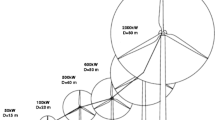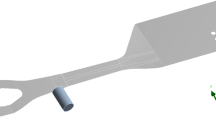Abstract
Wind turbine blades are the key components that allow the extraction of energy from the wind; these blades are often subjected to accidental impacts which usually occurs on moving blades with maintenance tools, hail, or flying birds, resulting in a significant degradation of the structural integrity of the blade. In this paper, a numerical simulation is adopted using finite element method (FEM) with ABAQUS software to investigate the mechanical behavior of a GRP composite wind turbine blade under low-velocity impact in operating conditions. On the other hand, damage modeling was formulated based on Hashin criteria for intra-laminar damage to detect failure modes in large wind turbine blade, the sensitive zones, and the size of damaged areas. To investigate this situation, a comparative evaluation was carried out considering many impact scenarios and the main parameters such as the impactor geometry, velocity, and weight. The results are then examined and analyzed, which show that major damage appeared at the tip of the blade and on trailing edge. Furthermore, the impactor geometry affects the type of damage, the weight affects the size of the damaged area, while the impact velocity influences the mechanical response of the composite wind turbine blade.
























Similar content being viewed by others
Abbreviations
- HSNFCCRT:
-
Hashin criterion for fiber in compression
- HSNFTCRT:
-
Hashin criterion for fiber in tensión
- HSNMCCRT:
-
Hashin criterion for matrix in compression
- HSNMTCRT:
-
Hashin criterion for matrix in tensión
- E1 :
-
Longitudinal Young modulus
- E2 :
-
Transversal Young modulus
- E3 :
-
Young modulus along the thickness
- ν12, ν13, ν23 :
-
Poisson’s ratio
- G12 :
-
Shear modulus in 1–2 plane
- G13 :
-
Shear modulus in 1–3 plane
- G23 :
-
Shear modulus in 2–3 plane
- X T :
-
Longitudinal tensile strength
- X C :
-
Longitudinal compressive strength
- Y T :
-
Transverse tensile strength
- Y C :
-
Transverse compressive strength
- S LT :
-
Longitudinal shear strength
- S TT , :
-
Transverse shear strength
- G ft ; G fc ; G mt ; G mc :
-
Damage evolution coefficients
- ALLAE:
-
Artificial strain energy ALLIE: Total strain energy
- ALLSE:
-
Recoverable strain energy
- ALLMD:
-
Energy dissipated by damage
- ALLKE:
-
Kinetic energy
- ETOTAL:
-
Energy balance
References
Boudounit H, Tarfaoui M, Saifaoui D, Nachtane M (2020) Structural analysis of offshore wind turbine blades using finite element method. Wind Eng 44(2):168–180
Renewable energy benefits leveraging local capacity for offshore wind, https://www.irena.org/publications/2017/May/Leveraging-Local-Capacity-for-OffshoreWind (Consulted le 19 September 2018).
Renewable energy benefits leveraging local capacity for offshore wind, https://www.irena.org/publications/2018/May/Leveraging-Local-Capacity-for-OffshoreWind (Consulted le 19 September 2018).
Schubel PJ, Crossley RJ, Boateng EKG, Hutchinson JR (2013) Review of structural health and cure monitoring techniques for large wind turbine blades. Renew Energy 51:113–123
Schubel PJ, Crossley RJ (2012) Wind turbine blade design. Energies 5(9):3425–3449
Dehouck V, Lateb M, Sacheau J, Fellouah H (2018) Application of the blade element momentum theory to design horizontal axis wind turbine blades. J Sol Energy Eng 140(1):014501
Mulugeta BA, Gerawork A (2017) Aerodynamic design of horizontal axis wind turbine blades. FME Trans 45(4):647–660
Shen X, Zhu X, Du Z (2011) Wind turbine aerodynamics and loads control in wind shear flow. Energy 36(3):1424–1434
Bottasso CL, Campagnolo F, Petrović V (2014) Wind tunnel testing of scaled wind turbine models: beyond aerodynamics. J Wind Eng Ind Aerodyn 127:11–28
Brøndsted P, Lilholt H, Lystrup A (2005) Composite materials for wind power turbine blades. Annu Rev Mater Res 35:505–538
Sørensen BF, Jørgensen E, Debel CP, Jensen FM, Jensen HM, Jacobsen TK, Halling KM (2004) Improved design of large wind turbine blade of fibre composites based on studies of scale effects (Phase 1) Summary Report (Risø-R Report). Risø National Laboratory.
Shokrieh MM, Rafiee R (2006) Simulation of fatigue failure in a full composite wind turbine blade. Compos Struct 74(3):332–342
Montesano J, Chu H, Singh CV (2016) Development of a physics-based multi-scale progressive damage model for assessing the durability of wind turbine blades. Compos Struct 141:50–62
Montesano J, McCleave B, Singh CV (2018) Prediction of ply crack evolution and stiffness degradation in multidirectional symmetric laminates under multiaxial stress states. Compos B 133:53–67
Yang J, Peng C, Xiao J, Zeng J, Xing S, Jin J, Deng H (2013) Structural investigation of composite wind turbine blade considering structural collapse in full-scale static tests. Compos Struct 97:15–29
Overgaard LC, Lund E, Thomsen OT (2010) Structural collapse of a wind turbine blade. Part A: static test and equivalent single layered models. Compos Part A 41(2):257–270
Overgaard LCT, Lund E (2010) Structural collapse of a wind turbine blade. Part B: progressive interlaminar failure models. Compos Part A 41(2):271–283
Kennedy CR, Leen SB, ÓBrádaigh CM (2016) Immersed fatigue performance of glass fibre-reinforced composites for tidal turbine blade applications. J Bio Tribo Corros 2:12. https://doi.org/10.1007/s40735-016-0038-z
Tarfaoui M, Nachtane M, Khadimallah H, Saifaoui D (2017) Simulation of mechanical behavior and damage of a large composite wind turbine blade under critical loads. Appl Compos Mater 25:1–18
Lin CC, Lee YJ (2004) Stacking sequence optimization of laminated composite structures using genetic algorithm with local improvement. Compos Struct 63(3–4):339–345
Boudounit H, Tarfaoui M, Saifaoui D (2020) Modal analysis for optimal design of offshore wind turbine blades. Mater Today: Proceedings 30:998–1004. https://doi.org/10.1016/j.matpr.2020.04.373
Tarfaoui M, Nachtane M, Boudounit H (2020) Finite element analysis of composite offshore wind turbine blades under operating conditions. J Therm Sci Eng Appl 12(1):4042123
Tarfaoui M, Nachtane M, Shah OR, Boudounit H (2019) Numerical study of the structural static and fatigue strength of wind turbine blades. Mater Today 13:1215–1223
Boudounit H, Tarfaoui M, Saifaoui D (2019) Structural design and analysis of a 5mw offshore wind turbine blades under critical aerodynamic loads. 14th Congress of Mechanics, April 16–19, 2019 (Rabat, MOROCCO)
Boudounit H, Tarfaoui M, Saifaoui D (2017) Étude numérique d’une pale composite d’une éolienne flottante en service. 13ème Congrès de mécanique - CMM, Apr 2017, Meknès, Maroc. ffhal-01730071
Boudounit H, Saifaoui D (2020) Wind farm design approach: feasibility and optimization study-case of the Dakhla site in Morocco. J Appl Sci Environ Stud 3(1):26–36
Nachtane M, Tarfaoui M, El Moumen A, Saifaoui D (2017) Damage prediction of horizontal axis marine current turbines under hydrodynamic, hydrostatic and impacts loads. Compos Struct 170:146–157
Nachtane M, Tarfaoui M, Saifaoui D, El Moumen A, & Boudounit H (2017) Caractérisation mécanique d'une hydrolienne en matériau composite dans un environnement marin.
Geubelle PH, Baylor JS (1998) Impact-induced delamination of composites: a 2D simulation. Compos B 29(5):589–602
E. Trousset (2013) Prévision des dommages d'impact basse vitesse et basse énergie dans les composites à matrice organique stratifiés. Thèse de doctorat, Ecole nationale supérieure d'arts et métiers-ENSAM.
Hamitouche L, Tarfaoui M, Vautrin A (2008) An interface debonding law subject to viscous regularization for avoiding instability: application to the delamination problems. Eng Fract Mech 75(10):3084–3100
Pugh K, Rasool G, Stack MM (2018) Some thoughts on mapping tribological issues of wind turbine blades due to effects of onshore and offshore raindrop erosion. J Bio Tribo Corros 4:50. https://doi.org/10.1007/s40735-018-0165-9
Pugh K, Rasool G, Stack MM (2019) Raindrop erosion of composite materials: some views on the effect of bending stress on erosion mechanisms. J Bio Tribo Corros 5:45. https://doi.org/10.1007/s40735-019-0234-8
Ahamed RAR, Johnstone CM, Stack MM (2016) Impact angle effects on erosion maps of GFRP: applications to tidal turbines. J Bio Tribo Corros 2:14. https://doi.org/10.1007/s40735-016-0044-1
Abrate S (2001) Modeling of impacts on composite structures. Compos Struct 51(2):129–138
Davies GAO, Zhang X (1995) Impact damage prediction in carbon composite structures. Int J Impact Eng 16:149–170
Davies GAO, Olsson R (2004) Impact on composite structures. Aeronaut J 108:541–563
Olsson R (2000) Mass criterion for wave controlled impact response of composite plates. Compos A 31(8):879–887
Mitrevski T, Marshall I, Thomson R (2006) The influence of impactor shape on the damage to composite laminates. Compos Struct 76(1):116–122
Yamada SE, Sun CT (1978) Analysis of laminate strength and its distribution. J Compos Mater 12:275–284
L. J. Hart-Smith (1989) A new approach to fibrous composite laminate strength prediction. eighth DOD/NASA/FAA conference on fibrous composites in structural design, NASA CP-3087, Part 2, pp. 663–693. 3.
Hashin Z (1980) Failure criteria for unidirectional fiber composites. J Appl Mech 47(329–334):4
Author information
Authors and Affiliations
Corresponding author
Ethics declarations
Conflict of interest
On behalf of all authors, the corresponding author states that there is no conflict of interest.
Additional information
Publisher's Note
Springer Nature remains neutral with regard to jurisdictional claims in published maps and institutional affiliations.
Rights and permissions
About this article
Cite this article
Boudounit, H., Tarfaoui, M., Saifaoui, D. et al. Parametric Study of Accidental Impacts on an Offshore Wind Turbine Composite Blade. J Bio Tribo Corros 7, 33 (2021). https://doi.org/10.1007/s40735-021-00473-z
Received:
Revised:
Accepted:
Published:
DOI: https://doi.org/10.1007/s40735-021-00473-z




